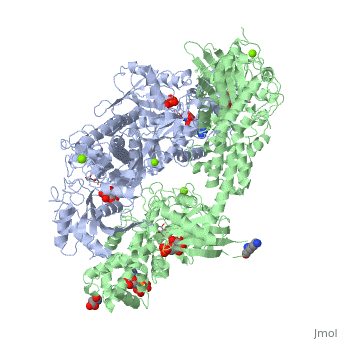Glycolysis is a key metabolic pathway for organisms. In it, glucose is converted into two pyruvate molecules. The process includes ten enzymes, described in further detail on the linked pages.
The first phase of glycolysis is sometimes referred to as the "investment phase", where ATP is consumed to set up later, energy generating steps. The first step of the pathway is the conversion of glucose to glucose-6-phosphate by either hexokinase or glucokinase. Hexokinases should not be confused with glucokinase, which is a specific isoform of hexokinase. All hexokinases are capable of phosphorylating several hexoses but glucokinase acts with a 50-fold lower substrate affinity and its main hexose substrate is glucose.[1]
Hexokinase:
Glucose-6-phosphate isomerizes to fructose-6-phosphate; this reaction is catalyzed by phosphoglucoisomerase. This isomerization allows for the creation of two, three carbon sugars as a product. Phosphofructokinase catalyzes the second phosphorylation reaction, and is the most highly regulated step of the pathway. Aldolase catalyzes the retro-aldol cleavage of fructose 1,6-bisphosphate into two three carbon phosphosugars, dihydroxyacetone phosphate and glyceraldehyde-3-phosphate. The interconversion of these two sugars is catalyzed by triose phosphate isomerase, also referred to as TIM.
The next five reactions are the "payoff" phase of glycolysis, where energy in the forms of ATP and NADH is generated. All of the subsequent reactions happen twice (once for each of the two glyceraldehyde 3 phosphate molecules generated from glucose). First, glyceraldehyde-3-phosphate dehydrogenase oxidizes glyceraldehyde-3-phosphate, transferring a hydride to NAD+, generating NADH and H+. A phosphate ion is used instead of a water molecule, leading to the formation of 1,3-bisphosphoglycerate, a high energy compound. Phosphoglycerate kinase catalyzes the transfer of a phosphate from the 1 position of 1,3-bisphosphoglycerate to ADP. This is the "break even" point of glycolysis: the two ATPs that were consumed in preparing for the cleavage have been now been regenerated, in addition to two molecules of NADH, which can be used to generate ATP through electron transport and oxidative phosphorylation.
The resultant 3-phosphoglycerate isomerizes to 2-phosphoglycerate in a reaction catalyzed by phosphoglycerate mutase. A second high energy intermediate, phosphoenolpyruvate, is formed by enolase. The final reaction of the pathway is catalyzed by pyruvate kinase, which converts phosphoenol pyruvate to pyruvate, while generating ATP from ADP.
The fates of pyruvate
Under oxidative conditions, pyruvate continues to be metabolized through the tricarboxylic acid cycle. While energy can be obtained under anaerobic conditions from glycolysis alone, the accumulation of pyruvate and NADH limits this. There are two main strategies for dealing with this problem. In most cells, lactate dehydrogenase converts the pyruvate and NADH to lactate, dealing with both problems at once and regenerating NAD+ so glycolysis can continue. Fortunately for us, some yeast cells do something else--leading to the generation of ethanol. First, pyruvate decarboxylase catalyzes the converstion from pyruvate to acetaldehyde, releasing carbon dioxide. Next, aldehyde dehydogenase reduces the acetaldehyde to ethanol, converting NADH to NAD+ in the process.
Additional Resources
For additional information, see:

